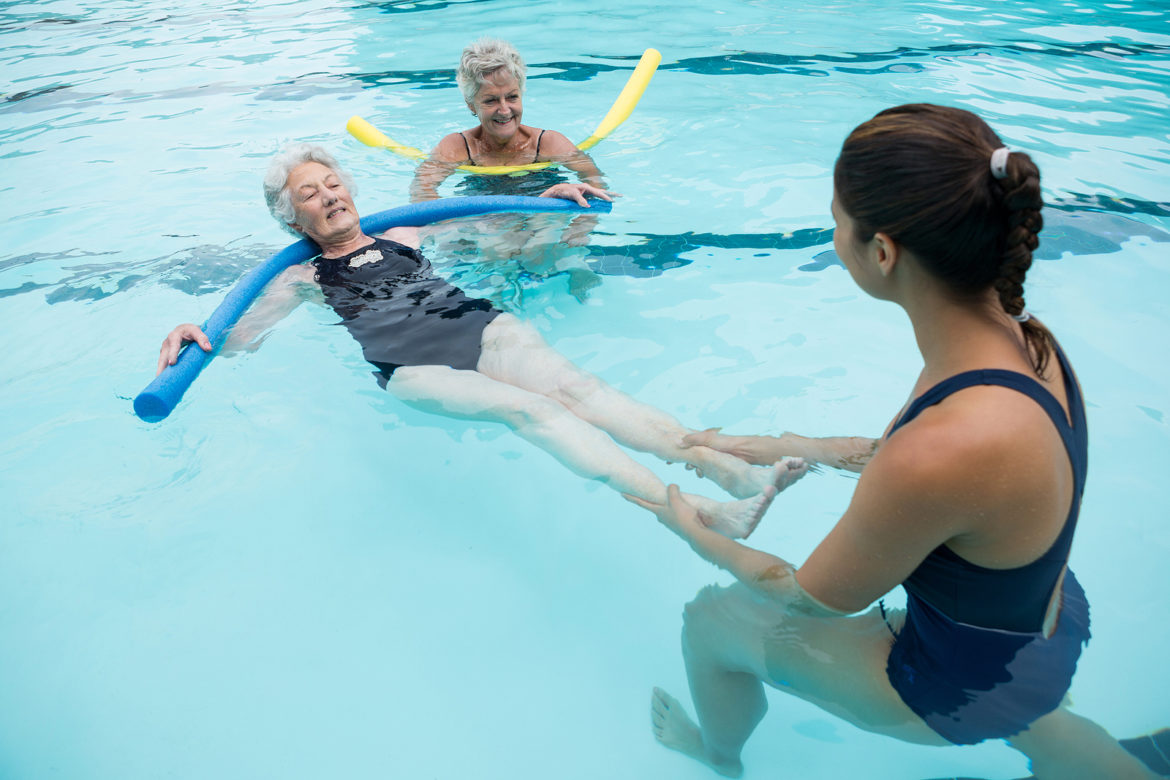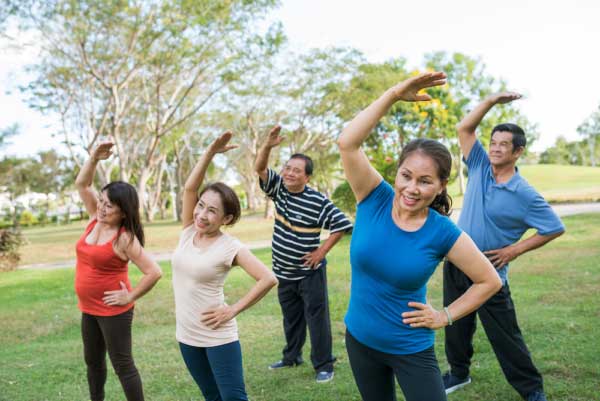If you are a cancer warrior, you are not alone in wondering how long after you are done with treatments should you start an exercise routine, especially when you may be feeling fatigue and nausea from treatments. The best way to find out is to consult your oncologist and care team!
Research found, those who exercised regularly had 40% to 50% less fatigue, the primary complaint during treatment. [1] Today, we will share more on how exercise can help cancer patients and specific exercises for cancer patients to practise.
Benefits of Exercise for Cancer Patients [2]
According to the U.S Department of Health and Human Services Physical Activity Guideline 2nd edition, cancer survivors (post-treatment) should engage in regular physical activity to reap the health benefits of it.
For adults with breast, colon, or prostate cancer, greater amounts of physical activity help to lower the risk of dying from their cancer. Cancer survivors who are physically active have a better quality of life, improved fitness and physical function, and experience less fatigue.
Physical activity also plays a role in reducing the adverse effects of cancer treatment, in particular, some cancer patients are at increased risk of heart disease and physical activity can help reduce this risk.
As cancer prevention, being physically active significantly lowers the risk of developing cancer. Research shows that adults participating in greater amounts of physical activity have reduced risks of developing cancers of the Breast, Colon, Lung, Bladder, Endometrium, Oesophagus, Kidney and Stomach.
Therefore, it is beneficial to engage in exercise at all stages of cancer – pre, during and post-treatment.
Recommended Amount And Type Of Exercise For Cancer Patients
The following recommendations are general guidelines from the U.S Department of Health and Human Services. Cancer patients should adjust the intensity and frequency of activity according to their body condition. If unsure, it is best to consult a professional for an activity plan tailored to each individual’s ability.
a) Cardiovascular Training
Cardiovascular exercises are also known as aerobic exercises, these are activities that get your heart pumping. Most people think of running and swimming when it comes to cardio activity but there are many other types of cardio exercises with varying levels of intensity. Always start with low-intensity activities before progressing your way up. The key is to ensure you work out at a pace and intensity that your body can handle.

It is recommended to perform 150 – 300 mins of moderate-intensity cardio exercise a week. To meet this, you can opt for moderate-intensity, vigorous-intensity activities or a combination of both.
It takes less time to get the same benefit from vigorous-intensity activities as compared to moderate-intensity activities. As a general rule of thumb, 2 mins of moderate-intensity activity counts the same a 1 min of vigorous-intensity activity [2]
Pro-tip: It is best to spread out your aerobic (cardio) exercise evenly through the week. For example, the patient can work out 5 times a week, each time doing a 30min session of moderate-intensity exercise. This adds up to at least 150mins/week.
Recommended cardio exercises for cancer patients:
1. Power Walking (moderate-intensity activity)
Simply pick up the pace, you don’t have to power walk like professional athletes! This is a great option for an easy low-impact cardio workout and is suitable for those with a weaker body.
Otherwise, normal walking is also counted as cardiovascular exercise. Even a 10 min walk can benefit your heart health. [3]
2. Hula-Hooping (moderate-intensity activity)
For a family-friendly activity, try hula-hooping with your children! It can provide similar results to other types of cardio activities like dancing. There are weighted and regular hula hoop options – both are a good way to get your cardio workout. [4]
3. Swimming (vigorous-intensity activity)

It is a low-impact form of cardio workout that protects your joints and at the same time keeps your heart rate up. It is also a great full-body workout!
4. Trampoline Rebounding (vigorous-intensity activity)
Sounds like a child’s activity but it is more beneficial for your health than you expect! Not only does rebounding on the trampoline work your heart, but it also improves your lymphatic circulation.
Rebounding on the trampoline can aid the opening and closing of your lymphatic valves simultaneously to increase lymph flow by as much as 15x. [5] With better lymphatic flow, toxins and harmful substances are filtered and cleared by the immune system more effectively which thus improves your immunity.
Rebounding on a trampoline also prevents excessive pressure on your joints so that you can work out for a longer period of time without affecting your joints!
👉 Read more about your lymphatic system
5. Cycling (vigorous-intensity activity)

A highly versatile form of exercise where you can choose to ride on a flat path or on tougher terrains if you are up for a challenge. Cycling is a good cardio workout that strengthens your lower body (legs, hips and glutes) but at the same time gentle on your back, hips, knees and ankles. [6]
We recommend taking your bike out for a ride at the nearby park to enjoy the fresh air. Otherwise, a stationary bike at the gym does the trick too.
b) Muscle-strengthening Training
Muscle-strengthening activities of moderate/greater intensity involve working the major muscle groups of the body – the legs, hips, back, chest, abdomen, shoulders, and arms. Such training for all major muscle groups should be done at least 2 days a week. A variety of activities is necessary to achieve balanced muscle strength.
Muscle-strengthening activities should be performed to the point where it is difficult to do another repetition (although there is no specific time recommendation).
Cancer patients should do a mix of cardiovascular and resistance training and not forgetting flexibility as well, such as stretching exercises, for added health benefits. Of course, if you are not able to meet the guidelines, intensity and frequency should be tailored according to your abilities and body condition.
Recommended muscle-strengthening exercises for cancer patients:
1. Squat
Muscle groups worked
- Quadriceps
- Hamstrings
- Glutes
- Abdominals
- Calves
Important cues:
1. The abdominals should always be tight and engaged as they help support the lower back throughout the exercise
2. You may squat as low as your ankle allows without your heels lifting off the ground.
3. Try to keep your torso as upright as possible
4. Prevent knees from caving in
The easiest form of squats would be a bodyweight squat. You can always increase this intensity by adding a resistance band around the knees so that you actively push the knees out and hold a dumbbell of your choice.
2. Lunge
Muscle groups worked
- Quadriceps
- Hamstrings
- Glutes
Important cues:
1. Keep body upright, shoulders relaxed
2. As you lunge, both knees should be at 90 degrees; back knee should not touch the ground
3. Keep the front heel on the ground
Start off with bodyweight forward lunges. You can then progress to reverse lunges and static lunges as well as hold dumbbells on each hand to make the lunge harder.
3. Overhead Press
Muscle groups worked:
- pectorals (chest)
- deltoids (shoulders)
- triceps (arms)
- trapezius (upper back)
Important cues:
1. Keep your knees and hips locked from start to finish. Do not use momentum to bring the weight up
2. Keep core braced. Do not arch the back
You may start out with a pair of dumbbells and progress by using an Olympic bar.
4. Push-ups
Muscle groups worked:
- Chest muscles, or pectorals
- Shoulders, or deltoids
- Triceps
- Abdominals
- Serratus anterior – the “wing” muscles directly under your armpit
Important cues:
1. Hands should be shoulder-width apart or slightly wider
2. As you lower your chest, your shoulders should be at a 45-degree angle to your body
3. Keep core engaged, do not let the hips sink
4. Hands should be under your shoulders, not too far forward
If you have difficulty performing a push-up, always start with knee push-ups first. When those start to get easy, progress by trying inclined pushups. If you can do regular pushups with good form you can increase the intensity by adjusting the pace; going down slow and pushing up fast. You may also use a resistance band over your back and hold it down with each hand to increase the tension when pushing up.
5. Rows
Muscles groups worked:
- Latissimus Dorsi
- Middle Trapezius and Rhomboids
- Biceps
- Erector Spinae
Important cues:
1. Always control the movement, do not swing your arm back to bring the weight up
2. Engage core and keep a neutral spine; do not round the lower back
3. Slight bend in the knees
4. Pull your elbows back to your hip
You may start off doing a single hand dumbbell row on the bench. Progress by doing double-handed bent over dumbbell rows and finally you may do bent-over rows with an Olympic bar.
6. Plank (30s/set)
Muscles worked:
- Transversus abdominis
- Rectus abdominis
- Internal oblique
- External oblique muscles
Important cues:
1. Do not collapse the lower back
2. Shoulders should be directly above the hands or elbows (for forearms plank)
3. Do not let your head drop
4. Keep the body in a straight line
You can increase the intensity of this exercise by trying side planks, holding on for a longer time or dynamic planks.
7. Glute Bridge
Muscles worked:
- Hamstrings
- Glutes
- Abdominals
- Lower back
Important cues:
1. Movement should be coming from your hips
2. Do not allow your back to arch
3. Feet about shoulder-width apart
4. Heels grounded
Start off with bodyweight, for progression, you may perform variations such as single-leg glute bridges or add resistance bands to your knees.
8. Lateral Banded Walk
Muscles worked:
- Glutes
- Quadriceps
- Hip abductors
Important cues:
1. Keep core engaged
2. Keep torso as upright as possible
3. Stay as low as you can while doing the walk
4. Push your knees out against the resistance of the bands
You may start off without weights. To increase the intensity, use tighter resistance bands.
We recommend doing 12-15 repetitions in each set of the above exercises and a total of 2-3 sets. For those requiring equipment such as dumbbells or resistance bands, we recommend starting off with light weights that you are comfortable with. Once you are used to the movement, you can explore heavier weights for more challenge!
Can Cancer Patients Do High-Intensity Interval Training (HIIT)?
As long as the cancer patient themselves is capable and fit enough to be able to do HIIT, they can do so. It would be wise to confirm with your oncologist before embarking on HIIT. If you have some limitations such as injuries, disabilities or poor fitness level, a better alternative would be to engage in continuous moderate-intensity cardiovascular activities.
Research found that HIIT has similar benefits as continuous moderate-intensity cardio activities such as reductions in cardiovascular disease risk factors. [2]
Considerations When Starting An Exercise Program During Cancer Treatment
Slow Progression
According to the National Comprehensive Cancer Network (NCCN), it is important to start slowly and progress incrementally.
Depending on fitness and comfort level, some people may want to start with a 10-minute walk around the block; others may find they can exercise for 20 minutes (or longer) right away. Your goal should be at least 30 minutes of aerobic exercise five days a week or more. [7]
Appropriate amount
Do not do too much at once as well. You may become discouraged and stop exercising altogether.
If you were exercising regularly before cancer, you may have to lower the intensity of workouts for quite some time. So it is important to manage your expectations for a smooth exercise program.
Some additional suggestion that may be useful [7]:
- Break up your sessions further if you cannot handle a long duration of cardio activity. Try three 10min walks during the day instead of one long 30 min walk.
- Make exercise enjoyable by getting a partner to do it with you or simply plug in music to accompany you while you run, swim or cycle.
- With exercising, you must warm up with simple movements and cool down with gentle stretches.
- Simply be more active. Be it climbing stairs instead of taking the lift or even doing some gardening, house cleaning, all of these activities provide some sort of physical activity.
- Consider yoga and tai chi. They promote mobility, flexibility and meditation for mind and body wellness.
- If you are on radiation therapy, avoid swimming pools; they can expose you to bacteria that may cause infections and the chlorine may irritate radiated skin.
- Lastly, listen to your body. If you are really not feeling well, take a break. You can always exercise another day.
Are you ready to embark on your fitness journey?
There are many ways in which you can incorporate physical activity into your lifestyle, there is no one size fit all workout routine nor is there the perfect exercise to do. It is about finding an activity that you enjoy so that you can continue exercising long term.
We strongly encourage cancer patients to engage in physical activity during and after treatment so that they can continue living life to the fullest and feel better faster. We hope this article gave you ideas on the types of exercises that are suitable for cancer patients to try out!
—–
This article is brought to you by Personal Trainers at Oompf Fitness
Oompf! fitness was founded in 2017 by Agnes Liew, ex-Banker, Entrepreneur and Fitness Lover. Her discovery of what it means to be fit and healthy transformed her life and she started Oompf! fitness to share her vision of becoming fit and fitter no matter your age or stage in life, and especially to empower women to age healthily and gracefully.
Our philosophy at Oompf! fitness is to promote a lifestyle that embraces fitness holistically; fit and healthy well-being habits need to be sustainable not trendy, in order to have a sustained lifetime of good health.
Additional References:
- American College Of Sports Medicine. 2018. The power Of Physical Activity: https://www.exerciseismedicine.org/support_page.php/physical-activity-health-impact/
Disclaimer:
The content on this page is for informational and educational purposes only. Such medical information may relate to disease, injury, drugs and other treatments, medical devices and/or health products. Medical information does not amount to advice, and if advice is needed an appropriate professional help should be sought. The disclaimer asserts that no warranties or representations are given in respect of the medical information, and that the website operator should not be held liable if a user suffers any injury or loss after relying upon the medical information.

